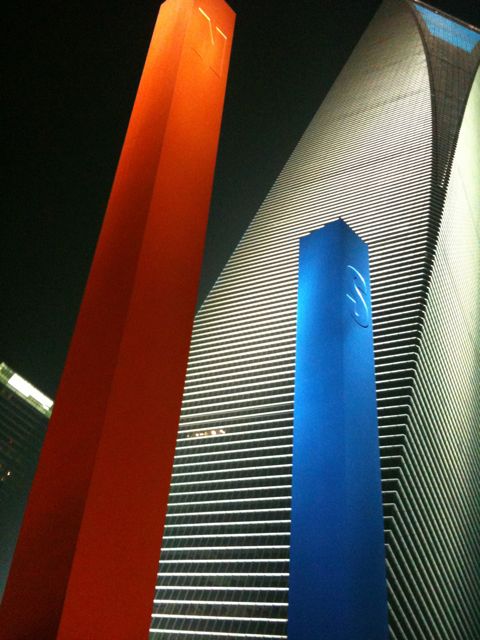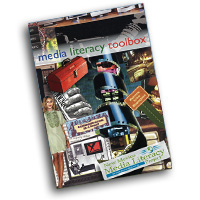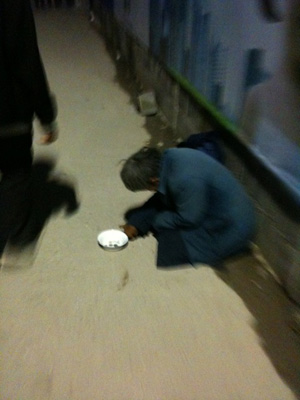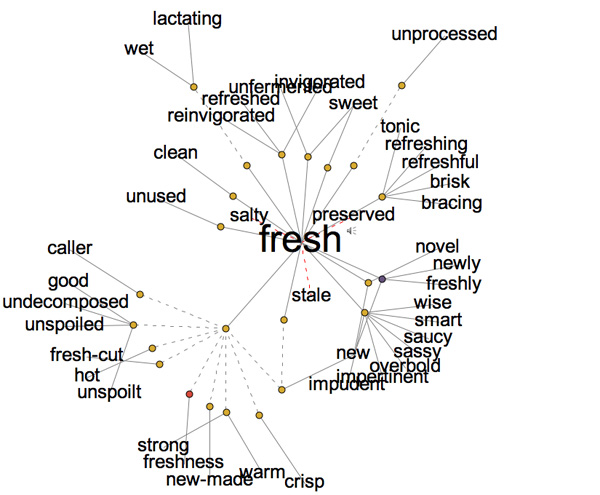
fno.org
|
|
| Vol 19|No 2|November 2009 | |
| Please feel free to e-mail this article to a friend, a principal, a parent, a colleague, a teacher librarian, a college professor, a poet, a magician, a vendor, an artist, a juggler, a student, a news reporter or to anyone else you think might enjoy it. | |||||||||||||||||||||
Flickring Heights: Using Digital Photography to Spark Student InventionBy Jamie McKenzie, ©2009, all rights reserved.About author Digital photography may spark a student's capacity to produce insights and ideas that are fresh and original.1 The taking and the editing of photographs with digital tools and software can clarify what it means to see, to capture and to report with a novel perspective. Engaging students in taking a daily photograph similar to the 365 projects on Flickr may transfer benefits into other domains such as writing, thinking, cooking, problem-solving and research. |
Shanghai World Financial Center
One of the tallest buildings in the world  © 2009, J. McKenzie, all rights reserved. |
||||||||||||||||||||
|
Due to unfortunate rituals that persist in many schools under the guise of "research assignments," many students engage in a scooping and smushing process that requires little thought or originality. Decades of topical research assignments have fostered lazy cut-and-paste thinking that rarely produces any work showing novelty or invention. When rated by the Taxonomy of Synthetic Thought and Production below, most of such work will fall to the bottom of the scale.
How Photography can Spark Student Invention Photography is a promising domain within which a student can experiment so as to grasp the basic strategies of creative thinking and synthesis. Using the above Taxonomy as a guide to emphasize originality, a teacher can challenge students to produce a photograph each day of the same person, pet or object for 30 days, keeping the results in a portfolio that will ultimately be presented as a collage and booklet. This approach came to me after experimenting myself with Project 365! on Flickr.
Seven views of the same cat (Charlie) on the same day all captured within about 15 minutes. I probably shot more than 20 pictures but these were the ones I have saved. If I were doing the one-a-day portfolio, I would have to select the one picture with the most pleasing and original elements. Some of the creativity comes with the framing of the shots with the camera. It was a matter of moving about the front porch as Charlie shifted positions, considering how much to zoom in on his face and how to make use of the context items like the cast iron railing, the steps and the wooden balustrades. After moving the shots from camera to computer, it was time to Photoshop the images, cropping them and adjusting colors as needed. Cropping supports focus and composition while also permitting the elimination of unwanted or distracting elements like a stray branch or some object that throws off the balance. All of these choices represent synthesis strategies - modifying elements of something to make it better. The role of the teacher with this project is to elevate the level of awareness so that students can identify and label the strategies employed. In class, students have an opportunity to show and tell. They preserve the original image as well as 3-4 generations of the image, all of which can be displayed on the white board or screen in the front of the room. As the image changes, the student explain what they did as well as why they made the change. Eventually, we look for transfer of these synthesis strategies into other realms. It might be cooking, for example. How might one change the saturation level of a sauce? It might be writing, for example. How might one brighten the tone of the words in that descriptive passage? For an extensive example of synthesis as applied to writing, note the questions at http://www.fno.org/sept98/infolit5.html. Ultimately, we hope they will learn to apply these strategies to the building of an idea, an opinion or a solution to a complex problem. Their grasp of such strategies will help them climb the Taxonomy mentioned at the beginning of this article. Learning by Example Flickr offers many examples of creative photography that may inspire both adults and children to understand the benefits of synthesis. One must use caution with the young, however, since some of the images on Flickr are for adult viewing only, and even though Flickr tries to protect the young by requiring photographers to classify their images in terms of safety levels, the system is far from perfect. Rather than encouraging students to wander in search of inspiration, the teacher might find examples like those below that show creativity without causing offense. These examples were chosen for use with adult teachers in a workshop and while seemingly free of nudity or offensive material, I have not read all of the words on all of the pages and am not recommending them for young children.
Animal photography might be another source of possibilities, as some folks take hundreds of shots of the same cat or dog without ever lapsing into boredom. This list might be a bit safer for young children.
Pictures of a building might also prove inspirational, as there are so many angles and possibilities to explore. On one visit I took lots of pictures of two very tall buildings in Shanghai - one being 100 Century Avenue - home of the World Financial Center - its neighbor being the Jin Mao Tower.
There are many famous buildings that have been photographed millions of times in often imaginative ways. A great activity for students is to compare and contrast the photographs of such buildings posted on Flickr. Which show artistry and originality? Which are clichés?
There are many other icons that might serve this exercise well, some of them mountains rivers and landforms, others such as bridges.
The possibilities are quite extensive, with iconic images proving especially fertile ground for consideration of cliché vs. originality. Practicing in the School Yard Some schools are fortunate to back up next to some woods or to offer some kind of playground with climbing apparatus. Now that many families own digital cameras, students could be asked to bring them to school for a playground photo-shoot. Teamed up as pairs or trios according to how many cameras are available, students are given 30 minutes to shoot no more than a dozen images per team, 2-3 of which are then transferred over to a class computer so the entire class can share and discuss not only the photos themselves but the strategies employed. Practicing at Home Even when many families have digital cameras at home, the teacher must check to make sure that every student in the class will have access to a camera, either by borrowing a school camera or by teaming with a friend. Expecting students to build their one-shot-per-day portfolios outside of school only makes sense if all students have ready access to cameras. In order to deepen students' understanding of the terms, "fresh" and "original" it pays to visit one of the thesaurus sites on the Web such as the Visual Thesaurus or Visuwords. These sites will help them to see the difference between counterfeits and knockoffs on the one hand and products that shine and sparkle. Diagrams like those reproduced below with permission from the Visual Thesaurus provide a rich understanding of the complexities involved. As students produce their own portfolios, they may apply such concepts to their own work.
These cluster diagrams were created at the VisualThesaurus.Com and are reproduced here with permission. Check out their Educator Resources page at http://www.visualthesaurus.com/educators |
|||||||||||||||||||||
|
Copyright Policy: Materials published in From Now On may be duplicated in hard copy format if unchanged in format and content for educational, nonprofit school district and university use only and may also be sent from person to person by e-mail. This copyright statement must be included. All other uses, transmissions and duplications are prohibited unless permission is granted expressly. Showing these pages remotely through frames is not permitted. |
|||||||||||||||||||||
Order your copy of The Media Literacy Toolbox from the FNO Store


 © 2009, Jamie McKenzie, all rights reserved. The article outlining
© 2009, Jamie McKenzie, all rights reserved. The article outlining














